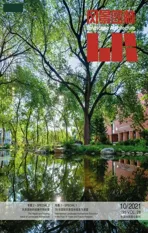将“感官体验漫步分析”用于多重感官体验的风景园林教学
2021-11-22丹尼尔罗尔魏菲宇肖恩贝利
(德/加)丹尼尔·罗尔 魏菲宇(加)肖恩·贝利
0 引言
当今可用于场地分析和表达的数字工具越来越具复杂性和可及性,致使风景园林学科研究方法在过去10年中发生了巨大的变化。技术创新扩大了风景园林行业在景观评价和建设方面的研究范围,也使其具备了解决全球规模问题——从气候变化到城市社会和环境问题的能力。近年来,增强现实软件已经开始可以协助风景园林项目的建设过程[1]。然而,对于数字技术的依赖可能会带来风景园林师脱离现场真实体验的风险,对环境的数字化感知可能会导致设计者缺乏对场地的深入而全面的理解。由于越来越鼓励使用数字工具,风景园林专业的学生和学者越来越忽视空间体验[2-3]。
有意识的感官体验对设计师来说十分重要,因其有助于进行包容性设计。而现有的花园和公园在设计时通常忽视人们和多重感官体验[4]。例如,关注鸟类的鸣叫声,可以提示设计师在观察现有空间或设计新空间时考虑鸟类迁徙问题。此外,由于新型冠状病毒肺炎(Corona Virus Disease 2019, COVID-19)疫情的蔓延,亟须提供具有包容性设计的开放空间促进人类的身心健康[5-8]。而研究表明,富于多感官体验的花园和公共开放空间恰好具备此类优点[8-16]。
目前除了用于特定治疗目的的空间外,设计师很少有意识地考虑多感官设计,并且为开放空间做多感官体验设计[11]。为了使设计师重视设计中的多感官体验并提高感知能力,至关重要的是,从设计教育开始,教师就应训练学生以多感官体验理解设计,并且学习满足多重感官体验的设计方法。这将使设计师在设计开放空间时,不仅要形成视觉刺激,而且要有意识地考虑所有感官体验。目前,视觉表现是风景园林设计过程中交流思想的主要手段[17-19]。但笔者认为,这种对视觉交流形式的过分关注会导致过于强调风景园林设计的视觉体验,并忽视其他感官体验。为了解决这一问题,笔者论述了提供多感官感知过程的方法和示例,以提高设计师对所有5种感官的关注:触觉、味觉、听觉、嗅觉和视觉。
笔者探索将“感官体验漫步分析”(Sensewalk Mapping)作为一种特定的体验式学习的方法,以增加感官知觉力、观察力和记录能力[20]。该方法为学生精心制定了指导策略,以深化学生对空间和多感官体验的理解。“感官体验漫步分析”可以增强多感官的景观感知,并在风景园林设计中开启多感官环境设计的新研究领域。本研究的目的是:1)阐述“感官体验漫步分析”的内涵;2)以现有的花园为例,说明该方法的应用;3)讨论如何将“感官体验漫步分析”作为数据收集工具;4)讨论该领域未来的研究方向。
1“感官体验漫步分析”
感官体验漫步(sensewalk)专注于超越视觉的感官刺激[21],这种逐步让人们了解个人感官及其空间内涵的方法增强了人们对其存在的空间意识。例如,木结构可能与其气味有关,但也与其触觉特征有关。“感官体验漫步分析”是将使用者的各种感官体验进行解析评价的过程,以得出某一场所的多重感官体验结论,并将此结论与场所设计相联系,为设计师提供指导。该分析方法为设计教育者提供了对学生进行多感官体验教育的机会,目的是让学生调动所有感官进行设计。
感官体验漫步并不是新鲜事物,且已经进行了数十年的试验。在20世纪70年代初,加拿大温哥华的西蒙菲莎大学(Simon Fraser University)引入“声音漫步”(soundwalks)的概念。当时游客被蒙上眼睛并被引导穿过花园,并记录下所有非视觉感受[21]。同样,谢菲尔德大学的研究员维多利亚·亨肖(Victoria Henshaw)组织了面向公众的“气味漫步”(smellwalks)活动,以研究人们对城市气味的感知[22]。艺术家和学者凯特·麦克莱恩(Kate McLean)组织了嗅觉之旅并用“气味地图”将她的行走路径可视化[23]。亨肖和麦克莱恩都鼓励公众进行有意识的多感官分析,并鼓励发展包容性环境设计方法,进而引导公众了解其如何影响城市生活质量[21-25]。
风景园林设计始于设计者沉浸在场地环境中,并通过感知来观察、记录环境。感官将人类的各种体验汇集在一起,形成对环境的印象[26]。景观感知是人们对环境复杂的认知和心理过程。简而言之,“景观感知研究人们对景观环境的感受以及人与景观环境的相互作用”[27]。信息通过人们的5种感官进行传递,进而使人们产生各种感知体验,并通过大脑将它们整合到对一个空间的完整印象中。多种感官的综合体验,结合对整体特征的情感反应,引导着人们对空间的认知和判断。这一过程创造了客观和主观的体验。
2 方法论
2.1“感官体验漫步分析”矩阵
笔者拟定了一个矩阵作为多感官体验的记录工具(表1)。该矩阵可以应用于多感官体验实践研究,作为用户进行多感官思考的指南,它适用于本研究后面讨论的实例研究。此矩阵可以作为学生、教育者和设计师进行现场调研的数据收集工具,以对不同感官的个人体验进行排名,从而促进人们有意识的景观感知研究。此矩阵是笔者根据自己作为设计师的经验创建的,未来矩阵的结构和内容可以进行调整,以更好地代表每个人作为特定空间访客的感知和感受。
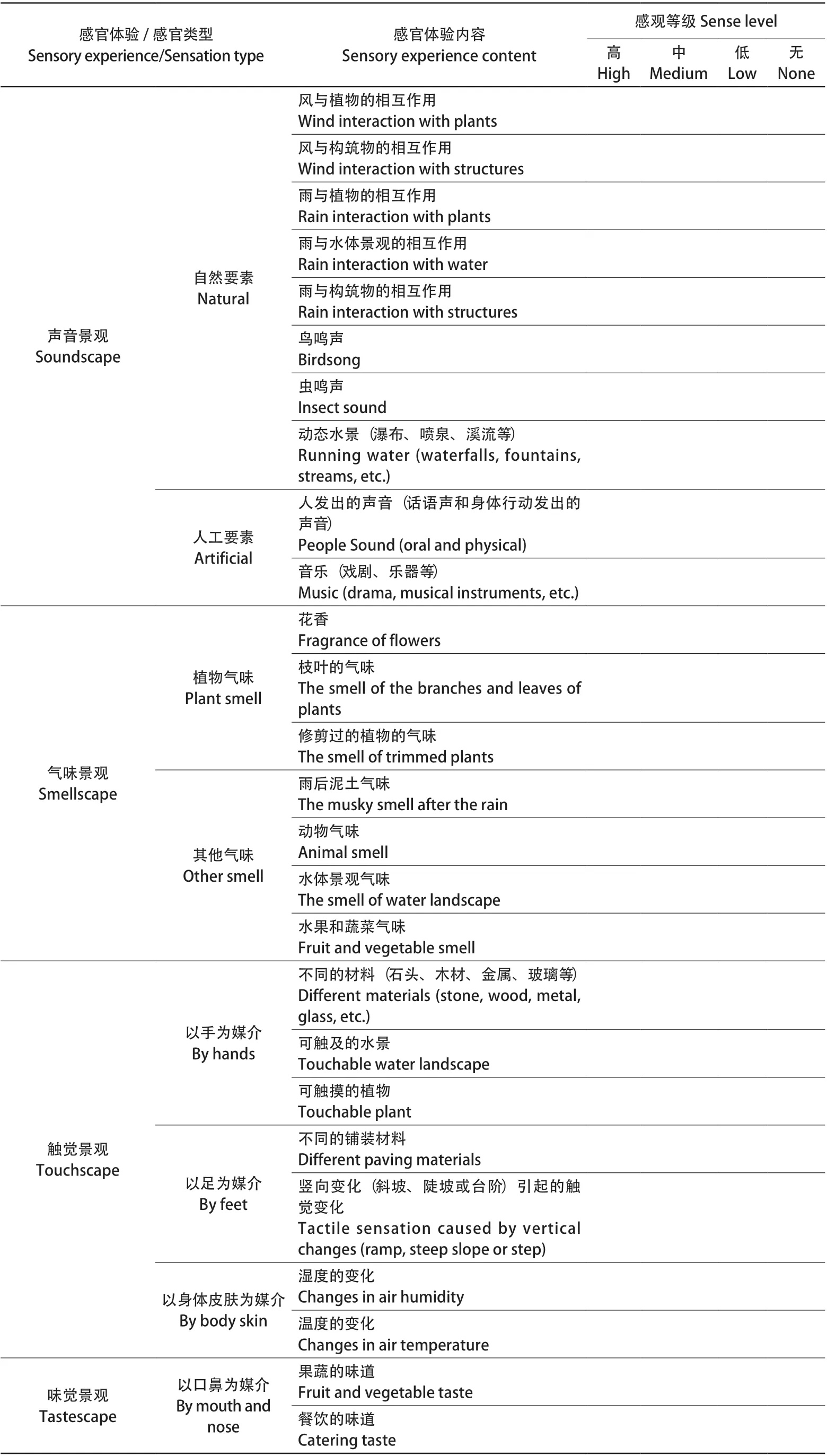
表1 多感官体验记录矩阵Tab. 1 Multisensory experience recording matrix
2.2 以中国古典园林为例进行“感官体验漫步分析”
已有有关声音和气味的感官体验研究,使设计师意识到环境设计中考虑多感官体验的必要性[21-24]。现有的研究为如何分别探索嗅觉、听觉、触觉和味觉提供了灵感。花园是空间实例,它可以在使用者访问过程中以可控的方式逐步提供多重感官体验。由于花园是充满愉悦的且能够增强人们环境体验的空间,例如植物的气味、水景的声音或亭子的降温效果,所以非常适合多感官体验漫步[8]。
“感官体验漫步分析”可以通过对中国古典园林的多感官体验分析来得到证明。基于对于花园的多感官体验的调查,笔者选择中国古典园林作为研究对象的花园。选择的原因是其空间尺度相对较小,并且有墙体为空间边界,为该研究创造了一个可控环境。中国古典园林是世界上有记载的最古老的园林之一,为多感官体验提供了广泛的可能性[28-31]。根据历史文献,这些中国古典园林的设计者有目的地为多种感官体验而设计[32-34]。中国古典园林激发了游客的想象力,并且蕴含着丰富的文化内涵。它们通过经典的意象和主题向游客传达精神意义。这些主题大多与中国传统文学、绘画和历史有关。园林通过多种空间营造手法,为游客带来不同的感官体验。参观者将身体的感官体验与对园林主题的认知理解结合起来,对空间进行全面的了解[35]。此外,近年来中国对多感官体验的研究有所增加,也对本研究选择的古典园林实例研究具有重要作用[33,36-39]。
笔者选择中国4个著名古典园林作为“感官体验漫步分析”的案例研究:1)扬州个园;2)北京恭王府花园;3)苏州沧浪亭;4)苏州拙政园。之所以选择这些花园,是因为它们体现了中国古典园林中典型的多感官体验设计思想。目前已有较多针对这些花园的研究,特别是对个园和拙政园的多感官体验进行分析[29,32,36]。此外,选择这4个园林还考虑到它们的建造时间,即从1004年到18世纪,数百年间这4个花园不断被重建、改建与修复。
3“感官体验漫步分析”矩阵在中国古典园林中的应用
笔者为每个花园设定了案例研究矩阵,描述了使用者的主要感官体验。由于本研究重点非视觉感官,因此在此特定矩阵中排除了视觉因素。此外,由于在列举的园林实例中没有发现专门的味道设计元素,所以味觉因素也被矩阵列表排除在外。未来的任何矩阵都可能包括或排除部分感官体验,以最适合其研究目的。笔者通过现场分析、研究地图、照片和文献综述,已经确定了某些感官体验。感官分析基于园林的基本组成部分(植物、建筑、水体、地形)与自然条件(风、雨、阳光、温度和湿度)以及它们如何与感官相互作用。尽管矩阵中的一些体验仅存在于一年中的特定季节或天气条件下,但大多数体验都具有普遍适用性。由于不同地域的园林空间要素是共通的,如建筑、植物、水体、岩石、地形、道路、铺装等,对园林的感知和体验具有一定的关联性。这使设计师能够总结可广泛用于其他园林空间的体验类型。
本研究选择了个园、恭王府花园、沧浪亭、拙政园4处古典园林,分别进行多感官体验分析,以定性描述的文本作为观察结果记录(表2~5)。选择这4处古典园林,是因为它们在建设时间、建设规模、区域分布等多方面,能够充分证实中国古典园林中的多重感官体验设计,体现出感官体验的丰富性。笔者利用手绘轴测图展现了沧浪亭和拙政园“感官体验漫步分析”结果,并显示出每种感官体验的位置。从听觉、嗅觉、触觉等多重感官体验角度,对两处园林进行声音景观、气味景观、触觉景观解析。每张图示都专注于一种感官知觉,即触摸、声音、气味(图1、2)。

表2 以个园为例进行多感官体验描述Tab. 2 Take Geyuan Garden as examples to describe the multi-sensory experience

表3 以恭王府花园为例进行多感官体验描述Tab. 3 Take Prince Kung’s Mansion Garden as examples to describe the multi-sensory experience
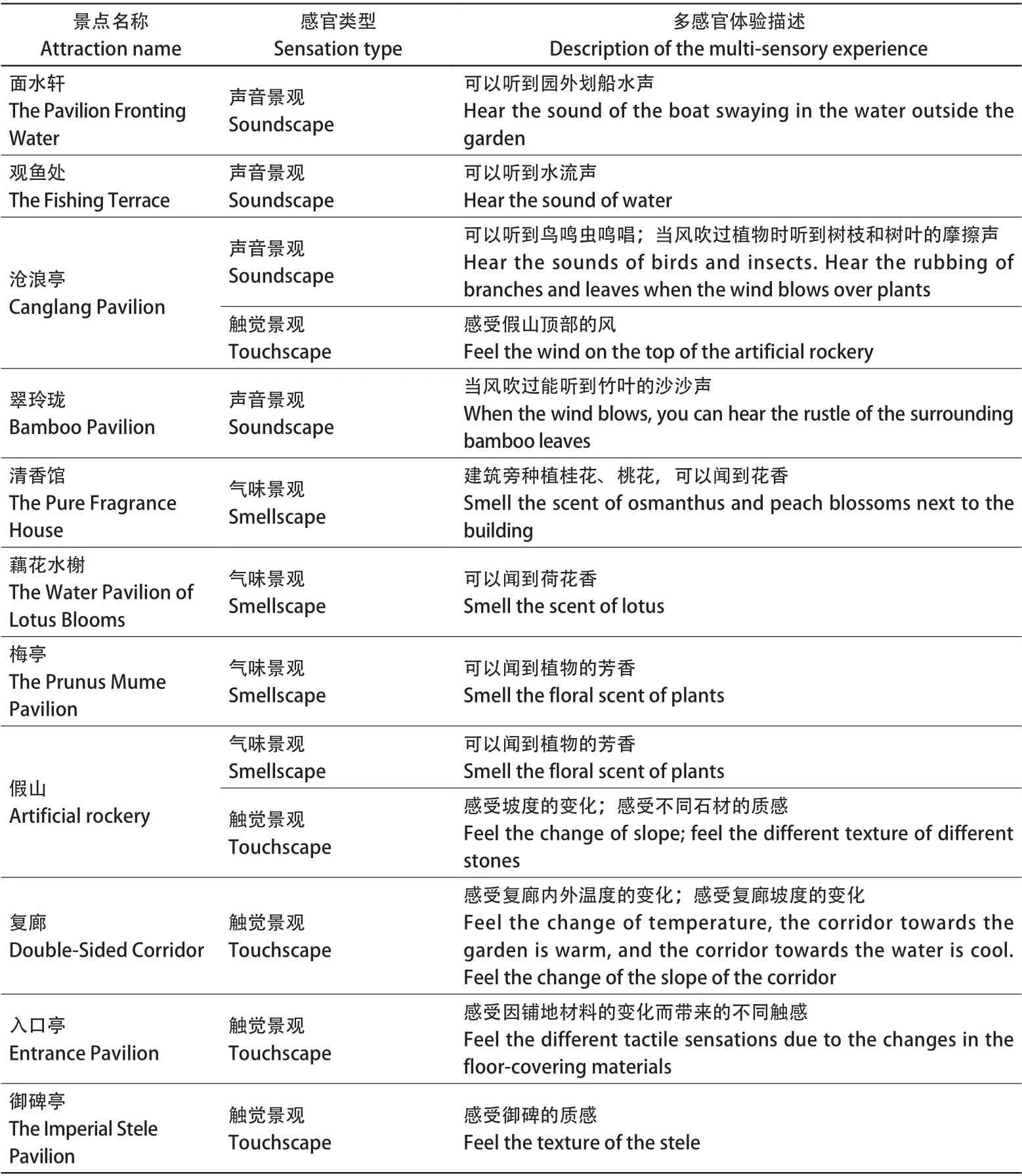
表4 以沧浪亭为例进行多感官体验描述Tab. 4 Take Canglang Pavilion as examples to describe the multi-sensory experience

表5 以拙政园为例进行多感官体验描述Tab. 5 Take The Humble Administrator’s Garden as examples to describe the multi-sensory experience
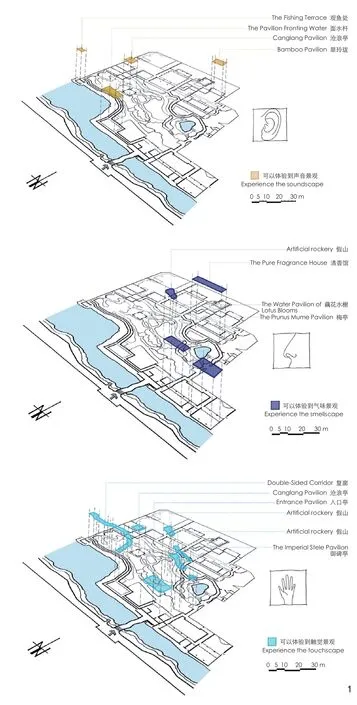
1 沧浪亭多重感官体验分析图Analysis diagram of multi-sensory experience of Canglang Pavilion
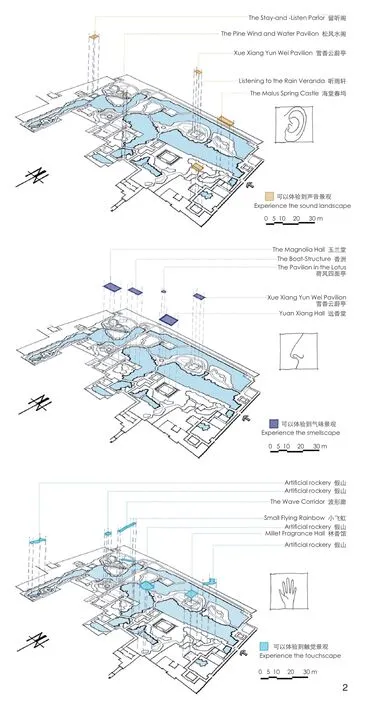
2 拙政园多重感官体验分析图Analysis diagram of multi-sensory experience of The Humble Administrator’s Garden
4 讨论
4.1“感官体验漫步分析”的价值体现
笔者认为,通过感官体验漫步进行的多感官分析将提高人们对场地的空间意识,从而对空间的理解不仅是视觉体验,还应是一种更强大的、多方面感官的体验。“感官体验漫步分析”可以帮助设计师、学者和访问者重新考虑自身对环境的观察,通过运用他们的记录和分析技巧,将所有5种感官体验都包括在设计过程中。通过感官漫步有意识地
收集信息,可以使我们的身体与周围环境建立更紧密的联系。笔者建议人们应该寻求更加身临其境的体验,并远离数字媒体。
矩阵是实施感官体验漫步的宝贵工具,可以是学生、学者和设计师在访问网站时轻松使用的工具;还可以促使访客考虑如何规划对园林空间的游览路径,以实现更具体和丰富的感官交互体验。例如,将矩阵与多感官空间引导图示相结合,可以使访客在特定的空间中的游览体验更为专注。
4.2 研究趋势
花园和开放空间可以被当作感官(眼睛、鼻子、舌头、皮肤和耳朵)与感官体验情绪之间认知联系的实验室。感官体验漫步研究可以扩展到分析多感官设计如何影响身心健康,及具体影响因素。本研究可有助于确定环境中需要哪些多感官条件来改善人们的身心健康。最近研究表明,参观和体验绿色开放空间有益于人类健康,尤其是在当前疫情蔓延的城市中[8-14]。
此外,在研究过程中收集有关网站上传的感官体验数据,也同样具有研究前景。园林中的多感官体验漫步可以引发新的数据收集与研究方法,以推动设计师有意识地将所有感官体验纳入环境设计中。例如,可以采用列表及简化的低、中、高等级,鼓励访客记录自我感官体验,并基于访客的情感感受对景观节点进行排名,从而实现数据收集。每个访客个体的感官体验都会受到不同因素的影响,例如兴趣点、文化背景、之前的体验等因素。在访问期间和访问结束后提供的在线调查,可以得出访客对感知点进行排名的详细信息,以显示特定感官体验的感知强度以及其如何使访客产生情感上的共鸣。这些数据可以为研究人员和设计师评估不同设计的多感官体验提供依据,例如水景的声音或芳香植物的气味,以帮助身心康复[11,20]。这些数据还可以进一步用于教学,帮助学生理解如何针对所有感官进行包容性设计。此外,还可以引导学生学习如何调动所有感官,针对个人感官数据进行空间研究,例如阐述特定空间的感官体验评论或绘制感官体验图表。从网络收集数据后,可以创建某一空间的多感官体验评价。
虽然本研究以中国古典园林为例,但世界各地域的不同园林类型都可以成为探索多感官体验的适宜场所。未来的研究可以继续探索不同类型的园林,以及分析封闭的环境设置是否更容易进行多感官体验分析。
4.3 讨论总结
1)引导式多感官分析让访客了解空间可以容纳多方面的体验,改变他们参与空间的体验方式。该矩阵可以成为有效工具,指导用户多重感官与空间互动,并促进花园或空间体验多样性。
2)矩阵可以成为教师培养学生多感官素养的教育资源。学生可以理解不同的设计空间干预如何导致不同的感官体验,使他们能够理解如何组织各种元素以获得丰富的感官体验,进一步丰富学生对设计的理解。
3)未来关于多感官体验漫步的研究可以发展为2个新研究领域:①一种新的数据收集方式,用于公园和花园中的多感官感知研究;②关注数据收集的位置,以研究如何设计公园和花园中的感官体验,进而影响访客的身心健康。
5 结论
本研究介绍了感官体验漫步和“感官体验漫步分析”,作为风景园林学、建筑学学者和游客多感官体验空间的工具。感官体验漫步被用作教学和学生自己练习对空间的主观感知、观察、记录和自我反思的手段。感官体验漫步能够培养多感官意识,从而在景观和建筑设计中实现更具包容性的设计思维。
本研究强调了在设计教学中进行感官体验感知教育的必要性。从实地考察、文献综述、感官数据收集和手绘地图4方面阐述了感官测绘的方法,在不同的图示上标注了触觉、听觉、嗅觉的不同感官体验。由于每个人的感官体验不同,可以参考本研究中的矩阵进行排序和记录,以供自己思考或研究。
“感官体验漫步分析”为学者创造了一个新的研究方向。通过收集访客数据,可以评价花园的多感官感知以及不同的感官如何促成访客的空间体验。此类信息有助于进一步了解多感官设计如何促进访客的身心健康。
沉浸在花园或公园空间中是一种动态的身体体验。环境生机勃勃,不断变化,重要的是人们需要有机会体验和欣赏这一点。如果设计师没有意识到多感官体验对其设计空间的影响,他们将继续在设计过程中优先考虑视觉因素。在当今世界,空间设计必须包罗万象,感官体验漫步可能是我们解决包容性设计教学过程的新方法。感官体验漫步增强了多感官意识,笔者希望通过此研究未来将改变设计师和学者对风景园林设计及研究的观念。
致谢:
感谢内达·鲁尼亚(Neda Roohnia)渲染感官体验漫步地图,感谢杰西卡·乌达尔(Jessica Udal)和米歇尔·加格农–克里利(Michelle Gagnon-Creely)对论文有见地的评论和编辑工作。
图表来源:
图1、2由Neda Roohnia改绘自《中国古典园林》;表1~5由作者绘制。
(编辑/刘昱霏)
“Sensewalk Mapping” as a Method for Teaching Multi-sensorial Landscape Perception
(DEU/CAN) Daniel Roehr, WEI Feiyu, (CAN) Sean Bailey
0 Introduction
The sophistication and accessibility of digital tools for site analysis and representation has caused landscape architecture to evolve dramatically over the last decade. Technical innovations have allowed the profession to widen its scope in landscape diagnostics and construction, with the capability of tackling larger, global scale problems –from climate change to addressing social and environmental issues in cities. Recently, augmented reality programs have started assisting with the construction of landscape architecture projects[1].However, the reliance on digital technology can pose the risk of distancing the designer from site immersion. This could lead to digital perceptions of landscape that may lack a full understanding of the site. Due to the increased encouragement of utilizing digital tools, students and scholars of landscape architecture lack an understanding of the importance of the embodied spatial experience[2-3].
Conscious perception of the senses is important for a designer as it helps to design inclusively and mindfully. Existing gardens and parks are often not consciously experienced multisensorially[4]. Noticing the singing of birds for example, can remind a designer to consider bird migration when observing an existing or designing a new space. Further, in light of the COVID-19 pandemic, the need for inclusively designed open spaces for physical and mental health benefits has been illustrated[5-8]. Research has shown that multisensorial experiences in gardens and public open space can provide these benefits for users[8-16].
Aside from spaces for specific healing purposes, multi-sensorial design is seldom consciously considered nor are open spaces intentionally designed for multi-sensorial experiences[11]. To provide designers with the appropriate tools required to perceive and design multi-sensorially, it is important that students learn and practice understanding the world through the five senses from the beginning of their design education. This will equip designers with the consciousness to design open spaces that not only stimulate vision, but intentionally include all senses.Currently, visual representation is the primary method for communicating ideas during the landscape design process[17-19]. It is the authors’ view that this focus on visual forms of communicating results in the overemphasis of the visual experience in landscape design itself. This comes at the cost of less consideration for the other senses that form the human experience of a landscape. To address this overemphasis on the visual, this essay aims to provide a methodology and examples of the multi-sensorial perception process, heightening the attention for all five senses: touch, taste, sound,smell and sight.
“Sensewalk Mapping” is explored as a method for prescribed experiential learning to increase sensory perception, observation and recording[20]. This methodology provides consciously orchestrated guidelines for students to develop an understanding of embodying a space and experiencing it multi-sensorially. “Sensewalk Mapping” allows for the enhancement of multisensorial landscape perception and the initiation of a new field of investigation in multi-sensory environmental design research in the field of landscape architecture. The aim of the essay is:1) to describe a methodology of “Sensewalk Mapping”, 2) to exemplify this methodology using precedent gardens, 3) to discuss how “Sensewalk Mapping” can be utilized as a data collection tool,and 4) to discuss and identify future areas of research in this domain.
1 “Sensewalk Mapping”
Sensewalks focus on the sensory stimuli outside of the visual[21]. This prescriptive step-bystep approach of learning about the individual senses and their spatial connotations enhances the consciousness of their existence. For example, a wood structure might be linked first to its smell but also to its tactile characteristics. This method provides an occasion for design educators to teach multi-sensorial literacy with the objective of having students design utilizing all the senses.
Sensewalks are not new and have been experimented with throughout the decades. The concept of “soundwalks” was introduced in the early 1970’s at Simon Fraser University in Vancouver, Canada, where visitors were blindfolded and physically guided through a garden, recording all non-visual sensations[21]. Similarly, Victoria Henshaw,a researcher at the University of Sheffield, organized“smellwalks” with the general public to research and understand the perception of urban smells[22].Finally, Kate McLean, an artist and scholar, organizes smellwalks and visualizes her participatory findings in smell maps[23]. Both Henshaw and McLean inspire the public to engage in conscious multi-sensorial analysis and develop an understanding of how other senses influence the living quality of cities, allowing for the development of design methods that encourage inclusive environments[21-25].
Landscape design begins with immersing oneself in the environment in order to observe and record it through perception. The senses bring together various human experiences and form an impression of the environment[26].Landscape perception is a complex cognitive and psychological process between the environment and its users. In short, “landscape perception is the study of people’s perception of the landscape environment and the interaction between people and the landscape environment”[27]. Information is transmitted as the user engages with their five senses, generating various perceptual experiences and integrating them into the complete impression of a space. The comprehensive experience of multiple senses guides cognitive judgement for making space combined with the emotional reaction to the overall characteristics. This creates experiences that are both objective and subjective.
2 Methodology
2.1 “Sensewalk Mapping” Matrix
A matrix was drafted as a recording tool for the multi-sensorial experience (Tab. 1). This matrix can be applied to site visits as a guide for users to begin to think multi-sensorially. It is applied to our precedent studies which are discussed later in this paper. This can be a tool for data collection for students, educators, and designers conducting site visits to rank the personal experiences of the different senses, thus increasing their awareness of conscious landscape perception and research.This particular matrix included here is an example created by the authors based on their own experiences as designers. The structure and content of future matrices can be adjusted to better represent each individual’s own perceptions and sensibilities as a visitor in a particular space.
2.2 Ancient Chinese Gardens as Precedents for“Sensewalk Mapping”
Previous sensewalk research surrounding sound and smell have encouraged designers to be more aware of the need for multi-sensorial considerations in environmental design[21-24]. Prior research provides inspiration on how to explore smell, sound, touch and taste individually, but not comprehensively. Gardens are an example of a space that can provide many multi-sensorial experiences during a single visit in a controlled step-by-step manner. They are perfectly suited for multi-sensorial experiences as they are spaces for pleasure and heightened environmental experiences such as the smell of plants, the sound of water features or the cooling effects of a gazebo[8].
“Sensewalk Mapping” is demonstrated through a multi-sensorial analysis of classical Chinese gardens. These gardens, which have been visited and researched, have been selected by the authors for their extensive multisensorial experiences. Chinese gardens have been chosen for their confined spatial design;an architecturally designed space bordered by walls, creating a controlled environment for this study. Chinese classical gardens are some of the oldest documented gardens in the world,providing extensive possibilities for multi-sensorial experiences[28-31]. According to historical documents,designers of these ancient gardens intentionally designed for multiple sensory experiences[32-34].Classical Chinese gardens stimulate the imagination of the visitors. They contain rich cultural connotations, emphasizing extraordinary meaning.They convey spiritual meaning to visitors through classic imagery themes. Most of these themes are related to traditional Chinese literature, paintings and history. The gardens bring different sensory experiences to the visitors through a variety of space creation techniques. In turn, the visitors combine the physical sensory experience with the cognitive understanding of the garden theme to develop a comprehensive understanding of the space[35]. Further, China’s research on multisensorial experiences has increased in recent years and played a major role in the literature review for the precedent gardens chosen in this paper[33,36-39].
Four well-known classic Chinese gardens were chosen as precedent studies for “Sensewalk Mapping”: 1) Geyuan Garden in Yangzhou,Jiangsu, 2) Prince Kung’s Mansion Garden in Beijing, 3) Canglang Pavilion in Suzhou and 4) The Humble Administrator’s Garden in Suzhou, Jiangsu. These gardens have been chosen because they embody ancient Chinese gardens and represent the typical multi-sensorial experiences of these gardens. Extensive research has been done on each of these gardens, in particular on the multi-sensorial experiences of Geyuan Garden and The Humble Administrator’s Garden[29,32,36].Additionally, the gardens were selected due to their construction time. Spanning from 1004 AD to the 18th century, the four gardens have been built,rebuilt and restored for hundreds of years.
3 Applying the Matrix to Classical Chinese Gardens
A case study matrix describing the main sensory experiences of the authors has been prepared for each garden. Sight has been excluded in this particular matrix as the authors’ focus was on non-visual senses. Taste was excluded as there were no intentional taste design components found in the precedent gardens. Any matrix conducted by others in the future may include or disclude senses in order to best fit its purposes for them.Sensory experiences have been identified through on-site analysis conducted by the authors as well as a literature review studying maps, photos and articles. The sensorial analysis examines the basic components of the garden (plants, buildings, water,topography) with natural conditions (wind, rain,sunlight, temperature and humidity) and how they interact with the senses. Although some experiences in the matrix exist during specific seasons or weather conditions of the year, most of these experiences have universal applicability. Because the elements of the garden space in different regions are common,such as buildings, plants, water, rocks, terrain, roads,and paving, etc., the perception and experience of the gardens have a certain interrelatedness. This allows us to summarize the types of experiences which can be widely used in other garden spaces.
The following tables provide multi-sensorial data for the four gardens chosen for our study.Observations were documented as qualitative text description (Tab. 2-5). Data was visualized spatially in hand rendered maps, showing the location of each sensorial experience. Two of the precedents,Canglang Pavilion and The Humble Administrator’s Garden, will be shown as examples of “Sensewalk Mapping”.
The following hand-drawn axonometric drawings are the result of the “sensory experience walk analysis” of Canglang Pavilion and The Humble Administrator’s Garden. From the perspective of multiple sensory experiences,such as hearing, smelling and touching, the maps analyzed the sound, smell and touchscape of the two gardens. Each figure focuses on one sensory perception: touch, sound, and smell (Fig. 1, 2).
4 Discussion
4.1 The Embodied Value of Sensewalks
The authors believe that a multi-sensorial analysis through “Sensewalk Mapping” will increase conscious awareness of a site, thus understanding spaces not simply as their visual experience but as a robust, multi-faceted experience. An embodied analysis could support designers, scholars and visitors to reconsider their own environmental observation by employing their recording and analysis skills to include all five senses in their design process. The information consciously gathered through sensewalks could develop a stronger connection of our bodies to our surrounding environments. The authors suggest that one should seek more immersive experiences,and step away from digital mediums.
The matrix is a valuable tool for performing sensewalks. It is a tool that is easily accessible for students, scholars and designers to use when visiting a site. It also provides an opportunity to consider how site tours might be adapted to consider a more embodied and multi-sensorial interaction with the site. For instance, the matrix in tandem with a guided map that directs one to multi-sensorial spaces could be a helpful system for encouraging users to become more mindful in a given space.
4.2 Further Research
Gardens and open spaces are living labs for discovering the cognitive connection between sensory receptors (eyes, nose, tongue, skin and ears) and the emotions felt through multisensorial experiences. Sensewalk research could be expanded to examine considerations of how multi-sensorial design impacts mental and physical health. This research could be useful to determine what multi-sensorial conditions are needed in the environment for improved mental and physical well-being. Recent research has shown that visiting and experiencing open green space has been beneficial for human well-being, especially in cities,particularly under current pandemic conditions[8-14].
There are also research opportunities for the ways in which we collect data about the experiential aspects of visiting sites. Multi-sensorial sensewalk experiences in gardens could be the starting point for a new method of data collection and research to enhance the conscious inclusion of all senses in environmental design. For instance, data collection could be achieved by recording the sensorial experiences in self-reflection surveys with a point evaluation scale or simplified low, medium, high value, ranking the emotional feelings and sensations encountered by users of a site. Each individual sensory experience is informed by a number of personal variables like what one chooses to pay attention to, cultural background, previous sensory experiences, etc. An online survey provided during and at the end of a visit could provide details on how visitors rank the perception intensity of a specific sensory experience and how it makes them feel emotionally. This data could be a useful resource for researchers and designers to evaluate the benefits of differently designed multi-sensorial experiences such as the calming sound of a water feature or fragrant planting to stimulate mental and physical healing[11,20]. The data could further be used to teach students how to design inclusively for all the senses. Additionally, if the purpose is to teach students to learn how to use other senses, it is important to give space for individual interpretation of the data such as providing space to write comments or draw diagrams. After the data is collected from the network, the multi-sensory experience evaluation of the garden is created.
Though this essay focuses on Chinese gardens, garden typologies throughout the world may be appropriate places to explore multisensorial experiences. Future research could address this. Future research could also investigate if a closed environmental setting is easier for multisensorial analysis.
4.3 Discussion Summary
1) Guided multi-sensorial analysis allows users to understand that spaces can hold multi-faceted experiences, changing the way they participate in space. The matrix can be a helpful tool in guiding users to interact with a space multi-sensorially and promote the multiplicity of experiences in a garden or space.
2) The matrix can be an educational resource for teaching multi-sensorial literacy to students.Students can determine how different design interventions lead to different sensory experiences,enabling them to understand how various elements are organized to obtain a rich sensorial experience.This will enrich their understanding of design.
3) Future research about multi-sensorial sensewalk experiences allows for two new areas of research: ①a new method of data collection for multi-sensorial perception research in parks and gardens; ②a new location of data collection to research how the senses in designed parks and gardens affect the mental and physical health of the users.
5 Conclusion
This paper introduces sensewalks and“Sensewalk Mapping” as tools for understanding a space multi-sensorially for landscape architecture and architecture students, scholars and visitors.Sensewalking is used as a means of teaching and practicing perception, observation, recording and self-reflection on one’s own subjective feelings about the space. Sensewalks foster multi-sensorial awareness, thereby allowing for more inclusive design thinking in landscape and architectural design.
This essay highlights the need to teach sensorial landscape perception in design pedagogy.It documents a methodology on sensory mapping;beginning with a site visit, literature review, sensory data recording, and hand-rendered maps. These maps locate the different sensorial experiences of touch, sound and smell on separate maps. The sensory experience is different for everyone and can then be ranked and recorded referring to our matrix for one’s own reflection or research.
Sensory mapping creates the possibility of a new research field for scholars. Through the collection of visitor data, the multi-sensorial perception of gardens and how the senses stimulate the experiences of every individual can be measured.This kind of information could also be helpful in further understanding how multi-sensorial design can support mental and physical health.
Site immersion in garden or park spaces is a dynamic bodily experience. The environment and landscape are alive and in constant change, and it is important that people have opportunities to experience and appreciate this. If designers are not aware of the impacts multi-sensorial experiences have on their designed spaces, they will continue to prioritize vision in their design process. In today’s world, spatial design must be all-inclusive. The proposed sensewalks might be the beginning for a new method of how we address teaching design process for inclusivity. Sensewalks enhance multisensorial consciousness and it is our hope that these experiences will alter future designers and scholars’views when designing and integrating multi-sensorial experiences in their own projects and research.
Acknowledgments:
The authors would like to thank Neda Roohnia for rendering the Sensewalk Maps, Jessica Udal and Michelle Gagnon-Creely for insightful comments and paper edits.
Sources of Figures and Tables:
Fig. 1-2 were drawn by Neda Roohnia fromClassical Chinese Gardens. Tab. 1-5 were created by the authors.
(Editor / LIU Yufei)
